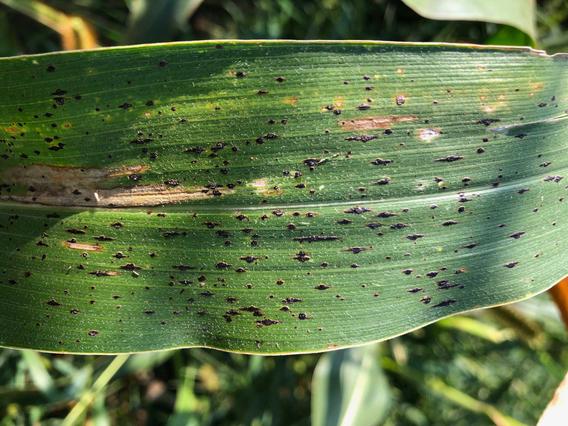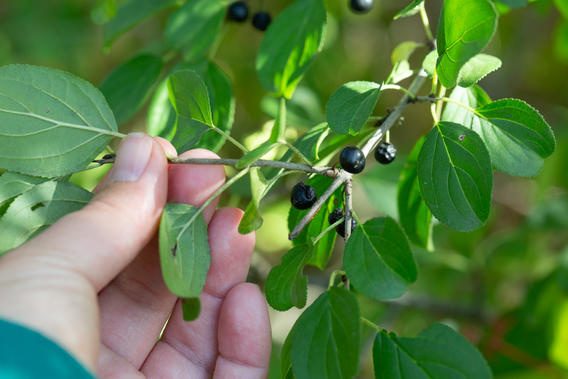February 1, 2023
The Minnesota Invasive Terrestrial Pests and Plants Center is excited to announce the start of 10 new research projects in January, 2023 with funding from the Environment and Natural Resources Trust Fund.
Over the next several years, the research teams of MITPPC's 10 new projects will investigate some of the most pressing terrestrial invasive species—corn tar spot, emerald ash borer, buckthorn, spongy moth, soybean aphid, and others. Their work will improve how the state of Minnesota detects, manages, and prevents these species that cause economic and environmental harm.
Read on for summaries of each new project, where you’ll find a link to each project page with more detailed information.

New projects
Understanding spread and development of corn tar spot in Minnesota
Led by Dean Malvick, Department of Plant Pathology
This project team seeks to generate information about corn tar spot in Minnesota in order to better enable risk assessment, mitigation, and management of the disease.
Effects of Puccinia species complex on common buckthorn
Led by Pablo D. Olivera Firpo, Department of Plant Pathology
Building on their prior MITPPC-funded research on rusts of glossy buckthorn, these researchers will identify the specific crown rust fungi that infect common buckthorn in Minnesota, determine the symptoms of disease, and document the host range of the pathogen. They’ll also evaluate the effects of the pathogen on common buckthorn.
Improving management of spongy moth in Minnesota
Led by Brian Aukema, Department of Entomology
Researchers will develop a Minnesota-based phenology model that will enable more effective use of the aerial spray to manage spongy months. They will also investigate the effects of the aerial spray on non-target organisms.
Developing pest-resistant soybean for sustainable management of soybean aphids and Japanese beetles
Led by Aaron Lorenz, Department of Agronomy and Plant Genetics
This research team will build on previous work to identify existing pest-resistant genes in soybeans and develop soybean varieties to help growers reduce insecticide use.
Incorporating adaptation into forecasts of range shifts with climate change
Led by Ryan Briscoe Runquist, Department of Plant and Microbial Biology
In Minnesota, common tansy has increased in abundance and is spreading southwest, despite species distribution models that predict otherwise. This research team will test the role of adaptation in range expansion and build models that account for past evolutionary change. The new models may be able to predict suitable habitat under current and future climates.

Biological control of buckthorn using fungi
Led by Robert Blanchette, Department of Plant Pathology
This research team will identify and study the effects of native fungi that have been found on buckthorn and evaluate the fungi’s potential use as a biological control against the invasive shrub.
Competitiveness and adaptability of Palmer amaranth in changing Minnesota climate
Led by Debalin Sarangi, Department of Agronomy and Plant Genetics
Researchers will develop knowledge on how Palmer amaranth adapts and competes in Minnesota, especially as we experience wetter springs and summer drought. This work will build a foundation for management strategies and future research.
Making revegetation as part of buckthorn management feasible in Minnesota
Led by Michael Schuster, Department of Forest Resources
Building on previously-funded MITPPC research on buckthorn, this team seeks to identify how to make revegetation with native plants a feasible, affordable solution for land managers working to eradicate buckthorn.
Genetic biocontrol of invasive insects, phase 3
Led by Michael Smanski, Department of Biochemistry, Molecular Biology, and Biophysics
This research team has established solutions for genetic biocontrol of spotted wing drosophila (SWD), however scientific and economic questions remain about carrying out treatment. In the third phase of this work, researchers will investigate these questions and evaluate how wild populations of SWD may impact genetic biocontrol.
Studies of entomopathogenic fungi for effective biocontrol of emerald ash borer, phase 2
Led by Robert Blanchette, Department of Plant Pathology
After studying the complex interactions between fungi and emerald ash borer (EAB), researchers will investigate using entomopathogenic fungi as biocontrol for the pest. This type of treatment would reduce the environmental impact of EAB management.